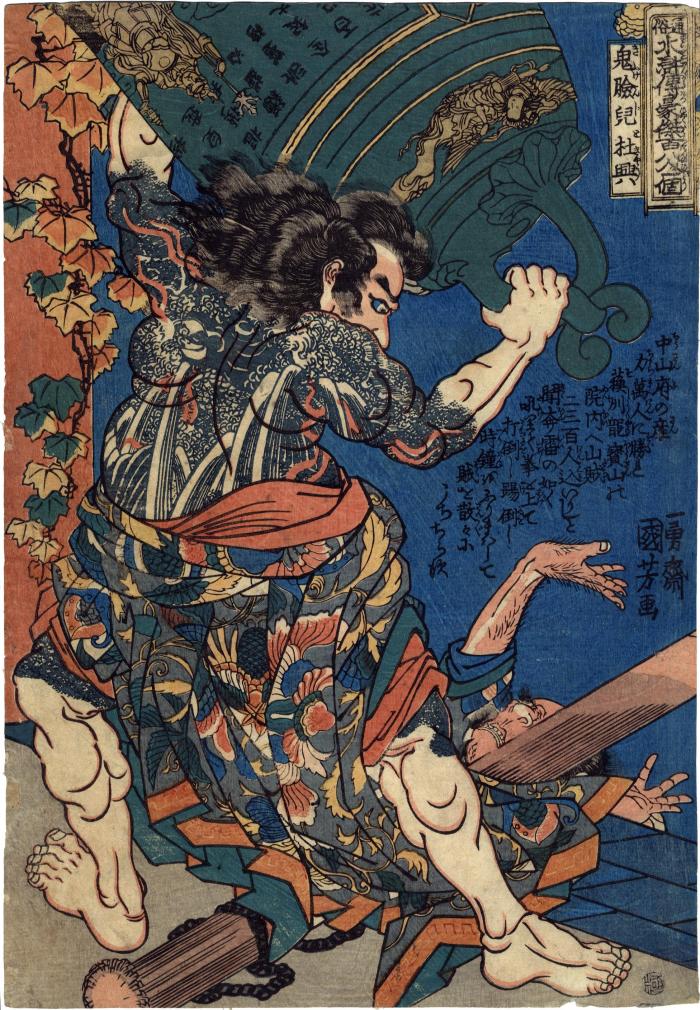Utagawa Kuniyoshi (歌川国芳) (artist 11/15/1797 – 03/05/1861)
Du Xing, the Devil-faced (Kirenji Tokō - 鬼臉兒杜興) from the series One Hundred and Eight Heroes of the Popular Shuihuzhuan (Tsūzoku Suikoden gōketsu hyakuhachinin no hitori - 通俗水滸伝豪傑百八人之一個)
ca 1827 – 1830
9.5 in x 14 in (Overall dimensions) Japanese woodblock print
Signed: Ichiyūsai Kuniyoshi ga
一勇斎国芳画
Censor's seal: kiwame
Publisher's seal mostly trimmed off,
but is probably Kagaya Kichiemon
Museum of Fine Arts, Boston
British Museum
The National Gallery in Prague The British Museum description of this print states: "Du Xing stripped to the waist and tattooed, lifting a huge temple bell to crush his opponent."
****
Du Xing is first mentioned, but not by name at the very end of Chapter 46. At the beginning of Chpater 47 of the Chinese version of the brigands of the marshes we find out who he is.
Yang Xiong raised the man to his feet and called Shi Xiu over.***
"Who is this brother?" asked Shi Xiu.
"Du Xing is his name. He's from the prefecture of Zhongshan. Because of his crude features everyone calls him Demon Face. Last year he came to Qizhou as a trader. He killed one of the other merchants in his company in a fight, and was brought before the prefect and committed to my prison. I talked with him and found him very knowledgeable about hand-to-hand fighting and jousting with staves. So I used my influence and got him off. I never expected to meet hi in this place."
There are two editions of this print. The first is by Kagaya Kichiemon 1827-30 and the second is by Ibaya Senzaburō (1843-47). Even though this print in the Lyon Collection is trimmed at the bottom and the publisher seal is almost completely gone, we believe this example is from the first edition, because those have a kiwame seal on them while the second edition has a different censor's seal, like the Watanabe Shōemon seal seen on the linked image at the Museum of Fine Arts, Boston.
****
Illustrated:
1) in color, the whole triptych in Ukiyo-e From Prague Revisiting Japan (プラハ 国立 美術館 所蔵 浮世絵展 : 開館 200周年 記念), 1995, p. 54.
2) in a full-page, color reproduction in Of Brigands and Bravery: Kuniyoshi's Heroes of the Suikoden by Inge Klompmakers, Hotei Publishing, 1998, #36, page 121. The author wrote: "In this print Tokō is about to crush a terrified man to death with an enormous bell. It is not exactly clear to which chapter this scene by Kuniyoshi makes reference, however, in chapter 58 the Ryōsanpaku heroes did use a precious golden bell in a cunning plan to free Kaoshō Rochishin... and Kyūmonryū Shishin... Tokō's body is tattooed with a dragon and a waterfall; these aspects are not mentioned inthe Shuihu zhuan. This print is one of a few in this series which is known to have been issued by two different publishers: one edition by Ibaya Sensaburō with a watari censor seal and another edition by Kagaya Kichibei with a kiwame censor seal [as with this one]. The Ibaya mark appears in the lower left while that of Kagaya is visible in the bottom right."
****
It should be noted that this figures name in kanji, 鬼臉兒杜興, is sometimes transliterated as Kirenji Tokō and other times as Kikenji Tokō. There are other slight variations in his name, but these two were the ones that we felt most compelled to point out. They appear to be interchangeable, but we don't know why.
Suikoden (水滸傳) (genre)
Tattoo (genre)
Kagaya Kichiemon (加賀屋吉右衛門) (publisher)
